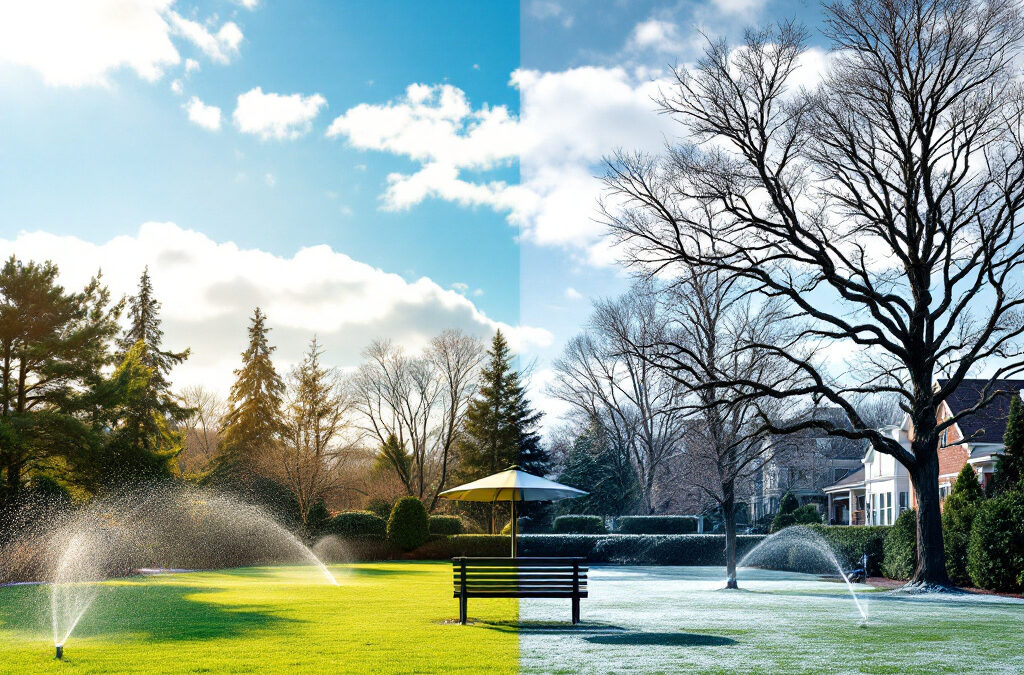Introduction
Seasonal lawn care is critical for maintaining the aesthetic appeal and health of commercial properties. A well-kept lawn not only enhances the beauty of the property but also leaves positive impressions on clients and visitors, boosting brand perception. Furthermore, proper lawn care increases property value, making it an essential investment for any business owner or property manager.
Understanding Seasonal Changes
Different Seasons and Their Impact on Lawns
Each season presents unique challenges and opportunities for lawn maintenance. In spring, lawns experience rapid growth and rejuvenation, requiring various care techniques to maximize health. Summer brings heat stress, demanding careful upkeep to prevent damage, while fall focuses on preparing the lawn for winter dormancy. In winter, lawns require protection to survive cold conditions and to be ready for the upcoming spring.
Regional Variations in Seasonal Lawn Care Needs
It’s important to note that lawn care requirements can differ significantly based on geographical location. Different climates affect growth patterns and seasonal challenges, meaning that property managers should tailor their lawn care strategies to regional conditions to achieve optimal results.
Spring Lawn Care
Cleaning and Debris Removal
As temperatures rise, the first step in spring lawn care is cleaning and removing debris accumulated over the winter. This includes leaves, branches, and other organic materials that can hinder growth. A thorough cleanup not only improves visual appeal but also enables sunlight and air to reach the soil more effectively.
Aeration and Dethatching
Aeration and dethatching are critical in spring to combat soil compaction and thatch buildup, which can stifle grass growth. Aeration creates holes in the ground, allowing for better air, nutrient, and water penetration. Dethatching, on the other hand, removes excess thatch to promote healthy lawn development.
Fertilization Strategies
Fertilization is essential in spring to replenish nutrients depleted over the winter months. Utilizing a well-balanced fertilizer can jumpstart growth and provide the necessary nutrients for thriving grass. Timing is key; applying fertilizer too late may lead to ineffective nutrient uptake.
Over-Seeding for Thicker Grass
To achieve a lush, dense lawn, over-seeding may be necessary in spring. This process involves spreading grass seed over existing turf to fill bare patches and improve lawn thickness. By doing this early in the season, property managers can encourage a stronger, healthier lawn.
Pest and Weed Control
Controlling pests and weeds is crucial at this stage, as they can quickly undermine lawn health. Implementing integrated pest management strategies during the spring minimizes infestations and prevents competition against desirable grass species. Regular monitoring is key for early detection.
Summer Lawn Care
Watering Techniques and Schedules
During the summer, effective watering techniques are essential for maintaining healthy grass. It’s best to water early in the morning or late in the evening to reduce evaporation. Deep, infrequent watering encourages root growth and improves drought resistance.
Mowing Height Adjustments
Adjusting mowing heights can help mitigate heat stress during the hot months. Keeping grass a bit longer enables it to retain moisture and provides shade for the root system. A height of three to four inches is generally ideal for most grass types in the summer.
Monitoring for Heat Stress
Property managers should regularly monitor lawns for signs of heat stress, such as browning or wilting grass. Addressing these symptoms early can help prevent permanent damage. Simple measures like increasing watering frequency or providing shade can be effective solutions.
Insect Pest Management
Summer often brings an increase in insect activity, necessitating proactive pest management strategies. Identifying and dealing with pests like grubs or chinch bugs can help preserve lawn health. Regular inspections and treatments can minimize the impact of these nuisances.
Importance of Lawns in Summer Events
Summer usually hosts many outdoor events, highlighting the importance of maintaining an inviting lawn. A well-cared-for lawn can enhance the overall atmosphere, impressing clients and guests alike. Therefore, prioritizing summer lawn care can yield significant benefits for commercial properties.
Fall Lawn Care
Raking Leaves and Debris Management
As autumn arrives, raking leaves and managing debris is essential to prevent mold and diseases from affecting the lawn. Allowing leaves to accumulate can suffocate the grass beneath, hindering its growth. Regular maintenance ensures the lawn remains healthy and vibrant going into winter.
Aeration and Overseeding
Once again, aeration and overseeding play vital roles in fall lawn care. Aerating aids in soil compaction relief while overseeding introduces new grass seed for a thicker lawn. Together, these processes establish a strong foundation for enduring winter conditions.
Mulching and Its Benefits
Mulching during fall has numerous benefits, such as retaining soil moisture and regulating temperature. Moreover, it enriches soil as it decomposes, feeding the grass below. Utilizing organic mulch provides a protective layer that keeps the lawn healthy throughout the colder months.
Fertilization for Winter Preparation
Applying a slow-release fertilizer in fall is key to preparing the lawn for winter dormancy. This preemptive measure provides the necessary nutrients that will be stored by the grass for spring growth. Proper fertilization will set the stage for a vibrant resurgence come spring.
Irrigation Adjustments Before Winter
As temperatures drop, it’s important to adjust irrigation schedules to prevent overwatering. Establishing a smart watering routine before winter ensures that the lawn receives adequate moisture without the risk of ice formation. Proper adjustments can help prevent winter damage effectively.
Winter Lawn Care
Protecting Lawns from Snow and Ice Damage
During the winter months, it’s crucial to protect lawns from the heavy weight of snow and ice, which can cause significant damage. Regularly clearing pathways and minimizing foot traffic can help reduce the risk. Additionally, keeping a layer of mulch can protect the grass from harsh winter conditions.
Planning for Spring Renovations
Winter is an excellent time for property managers to plan spring renovations. Evaluating lawn health and identifying areas for improvement will ensure that the property looks its best when the warmer months return. Strategic planning now can lead to successful implementation later.
Seasonal Equipment Storage and Maintenance
Proper storage and maintenance of lawn care equipment during winter can extend its lifespan. Cleaning, oiling, and securely storing tools prevents rust and damage from cold temperatures. This preparation also ensures that equipment is ready for use when spring arrives.
Addressing Winter Weeds
With dormancy, many lawns can be susceptible to winter weeds. Identifying and addressing these weeds early with appropriate treatments can keep them from becoming an issue in the spring. Taking proactive measures now can save time and resources later.
Year-Round Maintenance Practices
Routine Inspections and Monitoring
Implementing year-round maintenance practices is essential for maintaining a healthy lawn. Regular inspections allow for early detection of issues, enabling timely intervention. Consistent monitoring helps to keep lawns thriving throughout the seasons.
Maintenance of Landscaping Elements
In addition to lawn care, maintaining landscaping elements surrounding commercial properties is crucial. Regular upkeep of trees, shrubs, and flower beds contributes to the overall appeal and cohesiveness of the property’s aesthetic. Incorporating these elements into the maintenance plan enhances visual interest.
Hiring Professionals vs. DIY
Deciding between hiring professionals for lawn care or opting for a DIY approach depends on the resources and expertise available. Professional services often yield better results with specialized knowledge and equipment. Conversely, diligent DIY efforts can be rewarding for property managers up for the challenge.
Conclusion
In conclusion, seasonal lawn care is vital for the health and appearance of commercial properties. By implementing best practices tailored to each season, property managers can enhance their property’s aesthetic and overall value. To achieve optimal results, consider enlisting professional lawn care services to ensure your property remains an attractive and welcoming place for all.
Contact us today at 916 562-2345 to get a personalized lawn care quote for your commercial property.


